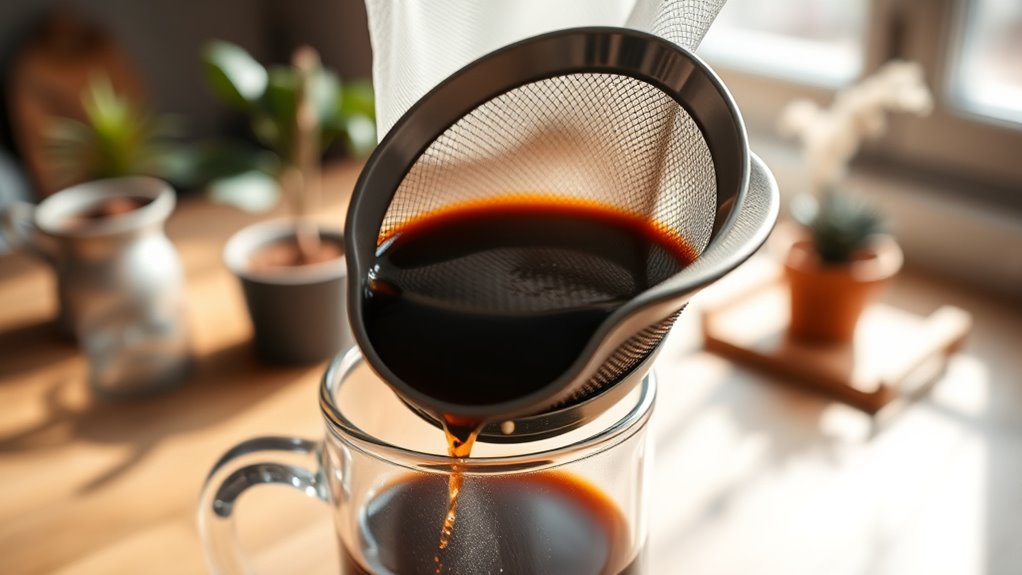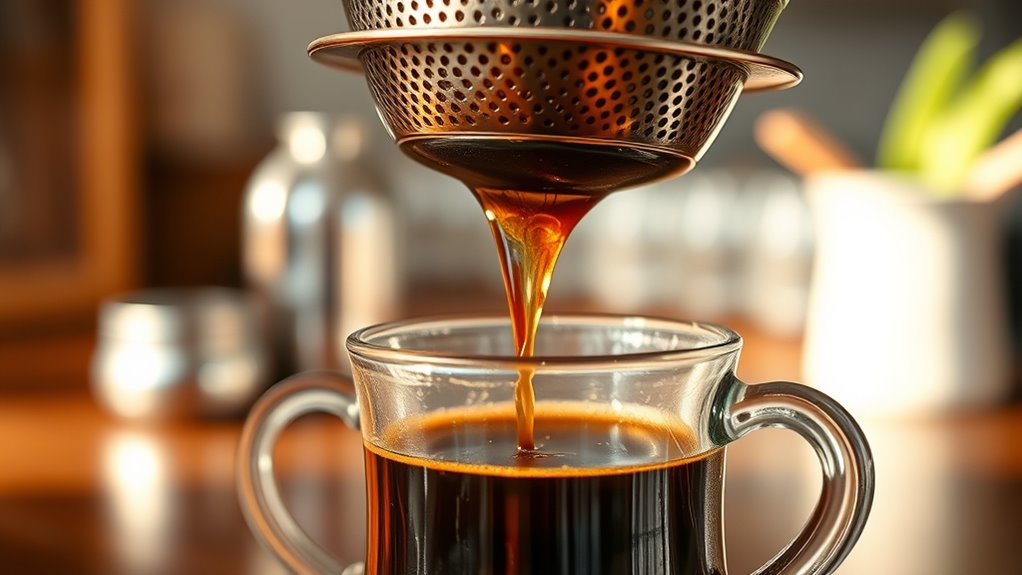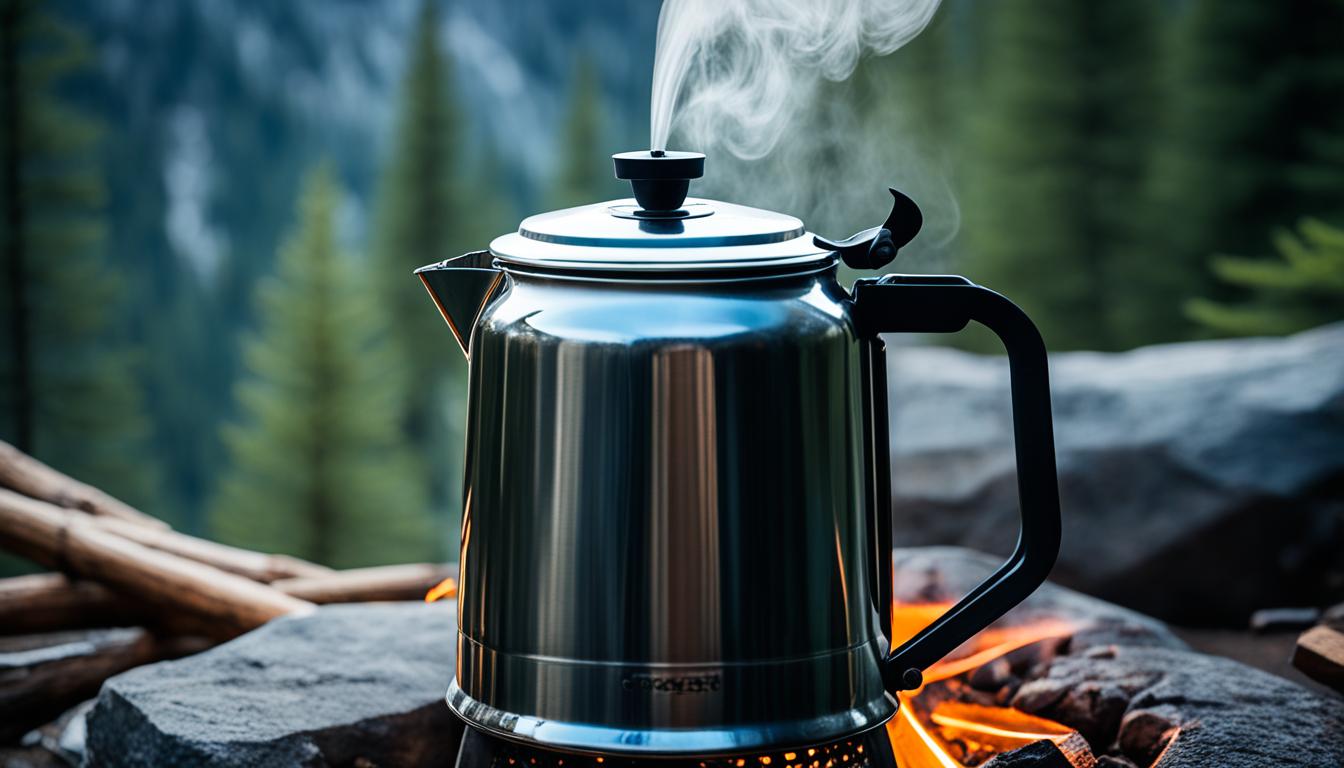To brew authentic Vietnamese coffee at home with a phin filter, start by selecting dark roast robusta beans and grind them to a medium-coarse consistency. Place the grounds into the filter chamber, press firmly, then pour hot water over the grounds slowly. Let it drip steadily for a rich, flavorful brew—adding sweetened condensed milk before pouring enhances taste. Gently stir once brewing is complete. If you keep going, you’ll discover more tips to perfect your method and enjoy true Vietnamese coffee.
Key Takeaways
- Use medium-coarse, robusta coffee grounds to ensure proper filtration and authentic flavor.
- Place the coffee in the phin filter, press firmly, then pour hot water slowly over the grounds.
- Allow the coffee to drip gradually for a rich, concentrated brew, enhancing aroma and flavor.
- For traditional Vietnamese style, add sweetened condensed milk before brewing or serve over ice.
- Gently stir the brewed coffee to blend flavors and enjoy immediately for an authentic experience.

Vietnamese coffee has become increasingly popular worldwide, and you can enjoy its rich, bold flavors right at home. To truly capture the essence of this vibrant coffee culture, you’ll want to master the traditional brewing techniques that make Vietnamese coffee distinctive. Using a phin filter, a simple yet effective tool, allows you to brew authentic Vietnamese coffee with minimal fuss. This method is central to the coffee culture in Vietnam, where the slow drip process creates a concentrated, flavorful cup that’s perfect for both sipping black or mixing with sweetened condensed milk.
Discover the art of Vietnamese coffee brewing with the traditional phin filter for rich, authentic flavors.
When you start, choose your coffee beans carefully. The best Vietnamese coffee blends are dark roast, often made from robusta beans, which contribute to the strong, full-bodied profile characteristic of Vietnamese coffee. Once you have your beans, grind them to a medium-coarse consistency—similar to sea salt—so they don’t slip through the phin filter’s mesh. Place the ground coffee into the filter chamber, firmly pressing it down to ensure even extraction. This step is vital in achieving a balanced brew, as too loose or too tight can affect the flow rate and flavor. Consistent grind size is crucial for optimal extraction and flavor clarity.
Next, pour hot water—just off boiling—over the coffee grounds, filling the filter chamber. As the water slowly filters through, it extracts the bold flavors, dripping into your cup below. This slow brewing process is a hallmark of Vietnamese coffee culture; it encourages patience and appreciation for the rich aroma that fills your kitchen. If you prefer a stronger brew, let the water drip a bit longer, or add more coffee grounds. For a more traditional experience, you can place sweetened condensed milk at the bottom of your glass before brewing, allowing the hot coffee to mix with the sweet, creamy milk as it drips through. This method results in the iconic cà phê sữa đá, a chilled, sweetened coffee that’s perfect for hot days.
Brewing with a phin filter is straightforward but demands attention to detail, which is part of what makes it so satisfying. Once your coffee finishes dripping, give it a gentle stir to blend the flavors evenly before pouring over ice or enjoying it hot. This technique isn’t just about making coffee; it’s about embracing a part of Vietnamese heritage and the meticulous process that makes each cup special. By practicing these brewing techniques, you’ll deepen your connection to the coffee culture and experience the authentic taste of Vietnamese coffee right in your own home. Additionally, understanding the influence of sound vibrations on cellular health offers an intriguing perspective on how holistic practices can complement your coffee ritual.
Frequently Asked Questions
What Types of Coffee Beans Are Best for Vietnamese Coffee?
When choosing coffee bean varieties for Vietnamese coffee, you should look for beans with rich flavor profiles that can stand out even with brewing methods like the Phin filter. Darker roasts, such as Robusta and certain Arabica blends, tend to give you the bold, intense flavors characteristic of Vietnamese coffee. Ultimately, select beans that balance strength and smoothness, ensuring a satisfying, authentic taste experience.
How Do I Adjust Brewing Time for Stronger or Milder Coffee?
To adjust brew strength, focus on extraction timing. For a stronger coffee, increase the brewing time slightly by pressing the filter more gently so water stays in contact longer, extracting more flavor. To make it milder, shorten the extraction time by pressing more firmly or removing the filter earlier. Experiment with these adjustments to find the perfect balance for your taste, ensuring you’re controlling brew strength through precise extraction timing.
Can I Use a Different Filter if I Don’T Have a Phin?
Did you know that over 80% of coffee drinkers experiment with different brewing methods? If you don’t have a phin filter, you can definitely try alternative filters like a French press or pour-over. These options provide unique coffee flavor options and can still produce a rich, robust brew. Just remember, the key is to adjust grind size and brew time to match the filter you’re using for the best results.
How Do I Clean and Maintain My Phin Filter?
To keep your phin filter in top shape, follow a simple cleaning routine after each use. Disassemble the filter and rinse all parts thoroughly with warm water to remove coffee oils and residue. Avoid harsh chemicals, as they can damage the filter. Regular cleaning helps maintain filter longevity and ensures great-tasting coffee every time. If needed, occasionally soak in vinegar or baking soda for deep cleaning, but always rinse well afterward.
Is It Possible to Make Iced Vietnamese Coffee Using the Phin?
Imagine turning your morning brew into an icy splash of bold flavor. Yes, you can make iced Vietnamese coffee with a phin filter by brewing hot, strong coffee and then pouring it over a glass filled with ice—think of it as a quick cold brew. Store extra coffee properly in a sealed container, so your future iced delights stay fresh and delicious, ready to chill whenever you crave a kick of caffeine.
Conclusion
Brewing Vietnamese coffee at home is like crafting a warm hug in a cup—simple, satisfying, and uniquely flavorful. With a phin filter, you control every step, turning your kitchen into a mini coffee shop. So, embrace the process and enjoy the rich aroma filling your space. Before long, you’ll be savoring a cup that’s as inviting as a friend’s visit, making every morning feel special with just a little bit of effort.









